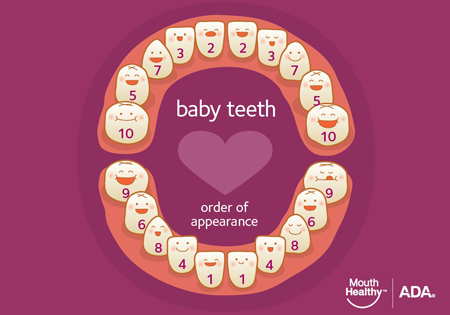
Teething and Teething Symptoms
Teething
Teething is the process of having teeth erupt into the mouth or oral cavity. Children get their teeth at different ages, but the teeth tend to erupt in a similar pattern despite differences in when they erupt. Typically children get their lower central front teeth first, followed by the uppers. Then they tend to get about 4 additional teeth every six months or so on average. Teething can be an unpleasant experience for young children and is often associated with the following signs and symptoms:
- Fussiness or irritability
- Sensitive gums and even some swelling of the gums
- Drooling, which sometimes causes a rash around the mouth
- Difficulty sleeping through the night
- Mild elevation in temperature, but not a true fever (over 100 degrees F)
It is important to point out that the literature endorsed by the American Academy of Pediatrics does not suggest that fevers or diarrhea are normal during teething. You can read the meta-analysis here:http://pediatrics.aappublications.org/content/pediatrics/137/3/e20153501.full.pdf
Eruption of Primary Teeth
Children begin to get their deciduous or primary teeth starting around the age of 6 months with the eruption of their lower central incisors. Eruption of the primary dentition continues from the age of 6 months to approximately 34 months until all 20 primary teeth are in the mouth. Do not be alarmed if your child’s teeth erupt early or a bit late, because there is large variability in eruption timelines, especially between boys and girls (girls tend to have tooth eruption earlier than boys).

Amber Necklaces
Amber
Amber is an amorphous solid that is created from fossilized tree resin. Amber is often used as a gemstone in jewelry, but it is often remembered as the source of DNA that brought the dinosaurs back to life in Jurassic Park. However, amber has made a come back in popular culture as a healing stone, and one that will ease the discomfort of teething.
Healing Properties of Amber
Amber has a long history of being considered a healing stone. Pliny the Elder wrote of its healing properties and its ability to help ailments of the “tonsillary glands and fauces.” Today, people often expound on the analgesic (pain relieving) and anti-inflammatory properties of succinate, which is present in certain types of amber. While it is true that succinate is important in the everyday function of living things and it can be distilled from a certain type of amber called Baltic Amber, it’s ability to help with teething is unlikely.
Amber and Succinate Debunked
In order for succinate to be released from Baltic Amber, it must reach a temperature that is much higher than that of the human body. Therefore, the release of succinate gas as an active ingredient to ease teething pain is simply ridiculous. Absorption through the skin is also nearly impossible as the concentration of succinate is very low, even in Baltic Amber. Remember, skin is a very good barrier to keep most substances out of the body, as it is our first line of defense. In an effort to keep an open mind, I found that even Dr. Weil, a well renowned medical doctor who promotes alternative medicine and nutrition, had little to say about amber teething necklaces. Dr. Low Dog, also an MD, and authority on botanical, Native American, and alternative medicine refutes the use of amber teething devices.
Why Amber Necklaces for Teething Can Be Dangerous?
Children and Choking
Young children, especially those of teething age, are at a high risk of choking. During this stage of development, the oral cavity is still a primary means of exploring and sensing the world. In addition, chewing is a natural instinct to relieve teething discomfort and promote tooth eruption. Amber necklaces often have small parts that can break free and a child could swallow the amber, or worse yet, choke on it.
Children and Strangulation
The American Academy of Pediatrics (AAP) does not recommend that infants wear any jewelry. Suffocation is the leading cause of death for children under a year old and among the top five causes of death for children between the ages of 1 and 4.
Parents who choose to use these necklaces are advised to:
- Always supervise your child when he or she is wearing the necklace or bracelet.
- Have your child wear the necklace on a wrist or ankle and not around his or her neck.
- Remember to remove the necklace or bracelet when your child is unattended, even if it is only for a short period of time!
- Remove the necklace or bracelet while your child is sleeping (day or night).
Alternatives to Amber Teething Necklaces
- Frozen Washcloth – place a clean damp washcloth in the freezer, then allow you child to teeth on it. This provides a cold soothing chewy that isn’t too hard. You may even twist or tie the cloth to give it a larger bulk for chewing.
- Plastic or rubber chew toy – there are many options out there, but the maker of the chewy tube has a great option for those children in the early teething months called Chewy Qs.
- Massage – using a clean finger, allow your child to chew on your finger while messaging the gums, this also helps with parent child bonding.
Teething Means Time to Schedule A First Dental Visit
Teething can be a rough time for parents, especially modern parents with a lot on their plate. But don’t forget, it is recommended that children see their pediatric dentist at the time of eruption of their first tooth or by a year old, whichever comes first. Establishing a dental home is an important part of a healthy and happy developing child.